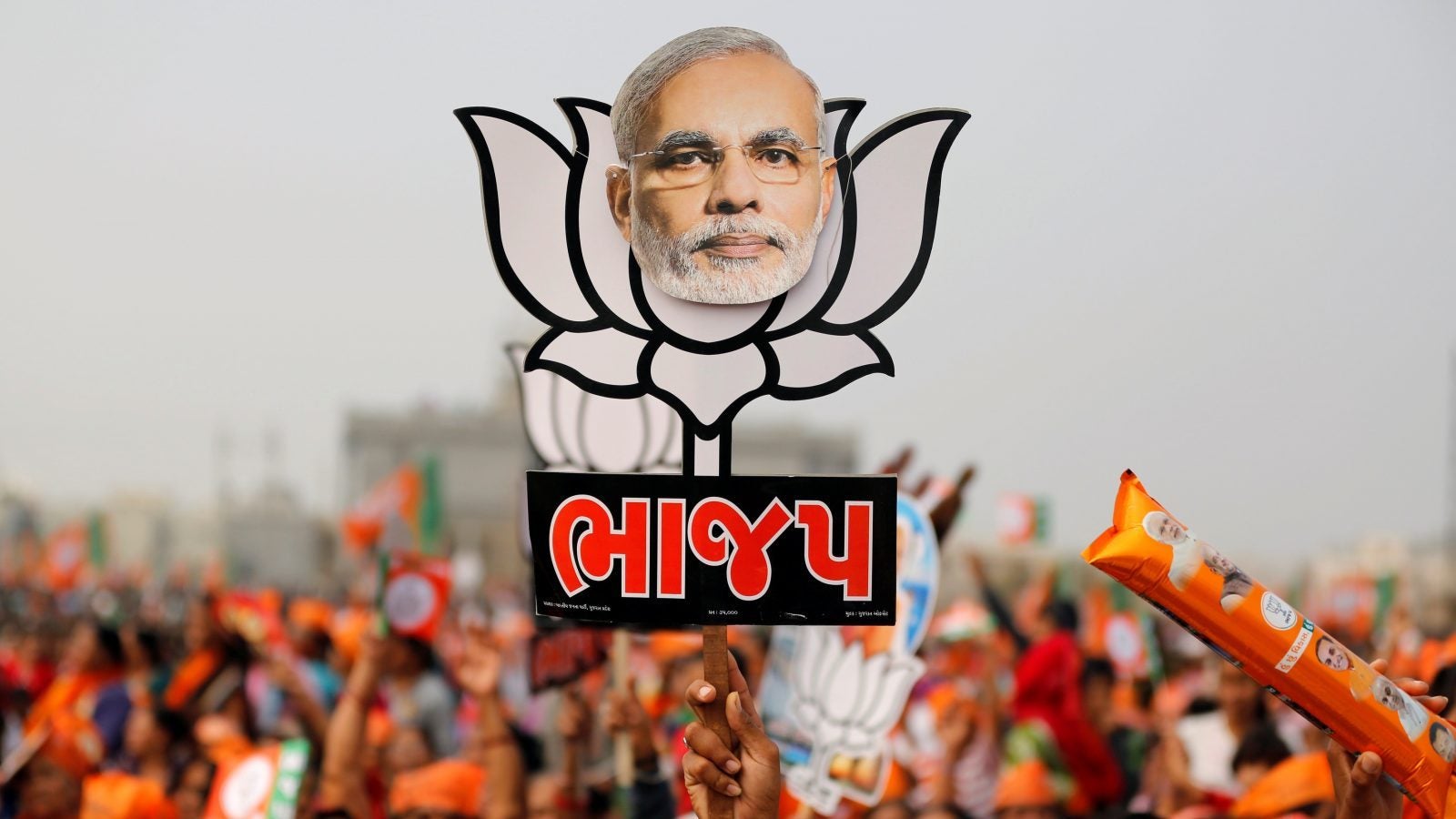Gujarat: The force is still with Modi but the resistance is rising
Prime minister Narendra Modi has passed his toughest test of 2017.


Prime minister Narendra Modi has passed his toughest test of 2017.
A year-and-a-half before India chooses its next national government, the key state of Gujarat has handed Modi and his Bharatiya Janata Party (BJP) a victory, but also a lot to worry about.
In the legislative elections held in the western Indian state on Dec. 08 and 14, the BJP has managed to hold on to power, adding another term to its 22-year-long run. At the time of publishing, it was poised to win 99 seats in the 182-member assembly, a remarkable performance considering the Indian electorate’s penchant for anti-incumbency.
However, by the standards set by its own narrative, the BJP victory rings somewhat hollow. Modi and his party poured everything into this campaign: launch of grand development projects, plenty of ultra-nationalist rhetoric, and crude religious innuendoes. And although BJP president Amit Shah’s target of winning 150 seats looked like a long shot, the party was expected to finish somewhere in the vicinity of the previous tally of 119.
Instead, aided by multiple grass-root rebellions in Gujarat, the rival Congress party put up a spirited show. Led by its recently anointed president, Rahul Gandhi, the party was staled to win 77 seats, 17 more than its 2012 figure.
So, while the victory will come as relief to the BJP as it builds up momentum for 2019, the Congress hasn’t crumpled either. After all, Gandhi, for long branded a part-time politician, did manage to take the fight to the enemy.
Why Gujarat?
The last time India held its breath awaiting the results of legislative polls was in the northern state of Uttar Pradesh, the country’s most populous and politically the most significant, in February-March this year. The BJP swept 312 seats out of the total 403 and returned to power after 15 years.
Although Gujarat isn’t as much of a weather-wane as Uttar Pradesh, it is nonetheless important.
First, because the state is where prime minister Modi burnished his credentials as an administrator and development-oriented leader—he ruled here as chief minister between 2001 and 2014 without losing an election. His three consecutive stints as chief minister of India’s third-most industrialised and fourth-most urbanised state were central to his political aura. A loss here would have severely dented his image. Now, with the home base secure, Modi can turn his focus to other states.
The second reason is the opposition Congress’s newfound energy. In the doldrums since its humiliating defeat in the 2014 general elections, the 132-year-old party has been struggling to find its feet. Apart from the odd victories in states like Punjab, the party has had no visible success in either forming governments or a national alternative to Modi’s blitzy narrative. Nobody was betting on it forming a government, but the fact that the Congress has considerably improved on its 2012 tally is being seen as a sign of a revival.
Here are the seat counts of the two main parties from the past few elections in Gujarat:
The following is the percentage vote share of the two parties over these years:
From its peak of 49.85% vote-share in the year 2002, when the state erupted in an orgy of communal violence, the BJP has steadily lost its support base, though never enough to threaten its hold over the state (This doesn’t include the handsome 60% vote-share it got in the 2014 national elections).
Yet, Amit Shah’s “Mission 150” clearly looks like a bridge too far now.
Acerbic campaign
The BJP was quick to point out the success of its development agenda in Gujarat.
However, development was hardly the party’s plank.
In a prestige battle for the two main parties and their leaders, the campaigns featured much acrimony and bad blood.
Modi, who had made the “Gujarat Model of Development” his calling card to woo national voters, didn’t quite deploy this supposed ace. Instead, during the nearly 40 rallies he attended in the state during the campaign, he mostly touched upon volatile subjects such as ultra-nationalism, Pakistan, the plan to build a temple at the site of a demolished medieval mosque in Uttar Pradesh, and of course the Gandhi family. Some accused Modi of lowering the stature of the prime minister’s position, besides puncturing his own aura by indulging in muckraking.
The Congress, on the other hand, had sought to ride on anti-incumbency by stitching together a coalition of castes—the Patidars or Patels, Dalits, and groups that form the other backward communities category. Over the past few years, the state had experienced several upheavals led by these communities, which have blamed the BJP for several of the social and economic grievances. Evidently, India’s grand old party wasn’t entirely successful.
What next?
Both the BJP and the Congress will end 2017 on a good note. The former particularly so as its Gujarat win was sweetened by another victory—also announced on Dec. 18—in Himachal Pradesh. Modi’s party cornered 44 of the total 68 seats in the northern hill state to defeat the incumbent Congress government.
Now as the two parties gear up for the 2019 national show, the two have a few more states to battle for in 2018 and 2019, including some key BJP-ruled provinces like Chhattisgarh and Madhya Pradesh where, too, anti-incumbency is likely to be a strong factor.
However, given what the BJP managed in Gujarat even after 22 years, these states could be anything but easy for the Congress. Yet, after giving the Modi-Shah juggernaut something of a scare, there’ll be a newfound confidence that the Congress will count on.